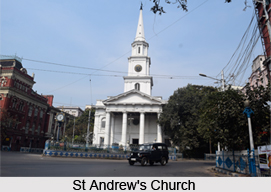 St Andrew`s Church was the seat of top religious minded Christian in the early British era. This church belonged from British East India Company and also the Earl of Moira (afterwards the Marquis of` Hastings), and the Scottish community in Kolkata, including the military. At that time, the Scottish community was the most important segment in early Kolkata.
St Andrew`s Church was the seat of top religious minded Christian in the early British era. This church belonged from British East India Company and also the Earl of Moira (afterwards the Marquis of` Hastings), and the Scottish community in Kolkata, including the military. At that time, the Scottish community was the most important segment in early Kolkata.
Location of St Andrew`s Church
St Andrew`s Church is situated in the Old Court House Street in the busy Dalhousie area of Kolkata. This church was built just on the site of Old Court House that was demolished by the British East India Company in the year 1792.
Foundation Stone of St Andrew"s Church
St Andrew`s Church was laid the foundation by the wife of the Governor General of India, Marquis of Hastings.
History of St Andrew"s Church
St Andrew`s Church was built by the Government of India especially for the people of Scotland living in early Kolkata. The Anglo-Indian Presbytery was created by the Charter of 1813 along with the Anglo India Episcopate. St Andrew`s Church was opened to the public only on March 8, 1818. The builders of St Andrew"s Church were Messrs Burn, Currie and Co. Dr Bryce, the priest of the church intended to build the church on a proper basis from the beginning and is recorded as having had a dispute with the Customs authorities on the Customs duty for the marble flooring. He was apparently finally allowed to import this duty free but we unfortunately are not told how. What resulted was a main plinth about seven feet above ground level, in Grecian style with a Christian spire or steeple. Both North and South porches are supported by massive Doric columns and are floored in white marble. Dr. Bryce, the priest of the church heard this, he declared that he would not only have a tower higher than the Cathedral Church of St John`s but would also place on the top of it a cock to crow over the bishop. Bishop was deeply embarrassed to hear the situation. Later, the Government of India that time declared the entire building might be repaired by the Public Works Department under British East India Company except the bird. The bird is still there.





















